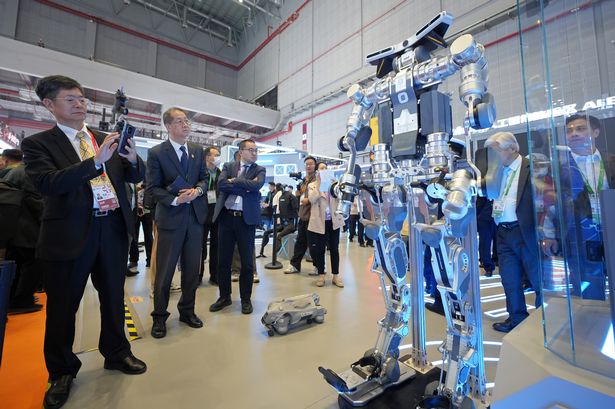China’s military has begun deploying advanced powered exoskeleton suits to enhance the capabilities of its soldiers. These next-generation suits, developed by Kestrel Defense, are designed to improve mobility and stamina for personnel operating high-tech weaponry, including drones. The People’s Liberation Army (PLA) is reportedly already utilizing this technology, with images emerging on Chinese social media showcasing troops equipped with exoskeletons that support unmanned aerial vehicle (UAV) operations.
The introduction of these exoskeletons marks a significant advancement in military technology, reminiscent of the fictional Iron Man suit. The suits feature a modular backpack housing a power source that connects to data equipment. The integrated helmet comes with a display system and an augmented reality visor, providing real-time situational awareness and enhancing the operator’s ability to coordinate drone feeds during missions.
Enhancing Combat Efficiency
This innovation is not entirely new in China, where similar exoskeletons have been employed in various sectors, such as home moving services, to minimize muscle strain. By integrating this technology into military operations, the PLA aims to prepare troops for extended combat engagements, where conserving energy is vital. The exoskeletons include articulated supports for the arms and legs, facilitating stability when soldiers are in crouched or kneeling positions, similar to how drone operators function during missions.
The deployment of these suits comes as the US Army has been exploring comparable exoskeleton technologies to assist their personnel with heavy-duty tasks. In March 2024, Palladyne AI Corp, formerly known as Sarcos Robotics, announced a contract with the US Navy and US Air Force to develop the Guardian™ XO suit. This full-body robotic exoskeleton is designed for military use and aims to enhance the physical capabilities of soldiers.
Palladyne reports that users of earlier exoskeleton models have been able to lift weights up to 90 kg effortlessly, attracting contracts across various sectors, including manufacturing, industrial, and military applications. While the specific features of the new Guardian™ XO suit remain undisclosed, it is expected to include a lightweight frame with powered joints to aid soldiers in transporting heavier loads efficiently in the field.
Future Implications
Promotional materials for the Kestrel exoskeleton suggest that it can support small quadcopters and reconnaissance drones. This capability allows for the deployment of these aerial devices directly from the suit, potentially transforming battlefield scenarios and enhancing real-time operational effectiveness.
As military forces worldwide continue to integrate advanced technologies, the adoption of powered exoskeleton suits signifies a shift towards more sophisticated combat strategies. The development of such technologies not only underscores the ongoing arms race in military innovation but also raises questions about the future landscape of warfare. As nations invest in enhancing soldier capabilities, the implications for global security dynamics are profound, warranting close attention from military analysts and policymakers alike.
In conclusion, the rollout of powered exoskeletons by China’s military represents a significant leap in military technology, with potential ramifications for both the PLA and its international counterparts. As these advancements continue to evolve, the global military community will closely monitor developments in this area.
